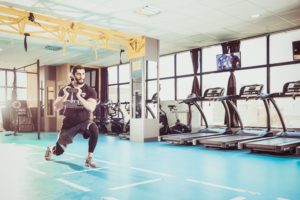Stability and mobility are both important aspects of athleticism. What exactly do these terms mean and how can runners incorporate them into their training to stay healthy and pain-free?

Runners often see a lot of buzzwords about the training they should do: stability vs. mobility vs. flexibility vs. postural control.
The terms are simple but may not be very clear, so let’s break these down:
- Stability is the control of your body during movement
- Mobility is the ability to control movement during muscle elongation
You’ll notice that both are heavily reliant on control. Getting your body into a specific position, such as an Instagram-worthy display of flexibility, may be impressive but it doesn’t do anything to prevent injuries or pain.
What matters is our ability to move into, out of, and through a pose. That control can impact our foot strike, cadence, body lean, and many other aspects of running.
What is a good starting place for working on controlled movement? And how can we simplify the process?
Today’s guest is well versed in these topics. He knows how to break down specific technique to actionable steps. Take a listen to this clip and try it for yourself:
Jay Dicharry Explains Controlled Movements
 Jay Dicharry is a physical therapist who rose to prominence as an expert in biomechanical analysis as Director of the SPEED Clinic at the University of Virginia.
Jay Dicharry is a physical therapist who rose to prominence as an expert in biomechanical analysis as Director of the SPEED Clinic at the University of Virginia.
He has written two books that are highly recommended for our community: Anatomy for Runners and Running Rewired. Jay also consults for several footwear companies, the US Air Force, and USA Track and Field.
Recently, Jay created and founded MOBO Board, an innovative foot stability tool that prioritizes a firm foundation to practice this valuable skill.
During our discussion today, we’re going to talk about the 4 skills that Jay deems absolutely necessary for healthy, pain-free running:
- Postural control
- Rotational stability
- Hip dominance
- Individual skeletal alignment
We get into specifics around different exercises, tests, and cues that you can leverage for your own running. Jay also explains how there movements aren’t just “extras” for your training. They form the core and can be progressed with added weights and wider ranges of motion.
I was inspired to assess and adjust my own running to help prevent injuries, based on Jay’s advice. I hope that you’ll find it valuable too!
Subscribe to the podcast in iTunes, Spotify, Stitcher, iHeartRadio, or Google Play.
Links & Resources from the Show:
- Connect with Jay on his website
- Helpful videos from Jay
- MOBO Board & Thoughts
- More injury prevention resources
Thank You InsideTracker!

Our show is supported by our longtime sponsor InsideTracker. Today, more than ever, it’s essential that we’re making the right decisions to keep our bodies healthy. To help us be resilient, prevent over-training, and optimize our running to get the most from it.
InsideTracker is the ultra-personalized nutrition platform that analyzes your blood and DNA biomarkers along with your lifestyle habits to help you optimize your body and reach your goals.
InsideTracker’s patented system will transform your body’s data into knowledge, insights, and a customized action plan of science-backed recommendations. The data can help you determine whether you’re running too much, not enough, or have some other issues that could be affecting your recovery or performance.
I’ve had my own blood drawn with InsideTracker several times and have been amazed at the valuable information that they provide. Not only are the results very detailed, but they also share guidance for how to improve any markers that are out of range.
If you’re ready to take control of your health and optimize your training, InsideTracker offers a selection of plans that best suit your needs. Use Code STRENGTHRUNNING at InsideTracker to save 10% of any of their tests.